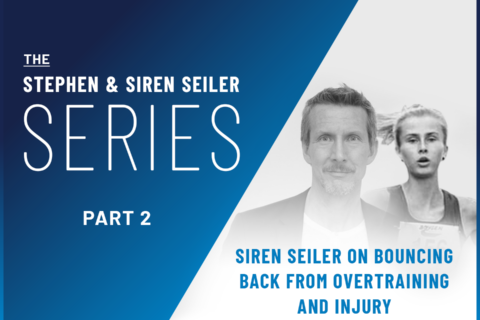Load, stress, strain—they’re terms we hear a lot in sports science, but what do they mean? Dr. Stephen Seiler explores how your internal response to external load will change as you become fitter and more durable.
Video Transcript
Rob Pickels 00:05
There are internal and external ways that we can quantify load. The external being the power or the pace that you’re running at. The internal being your heart rate, your breathing rate, your blood lactate. Is one of those the internal or the external, is that a more important driver of intensity? Should you say, if your heart rate is creeping up, should you back the power off to keep heart rate steady? Or should you keep the power the same, and let that heart rate or breathing rate increase?
Internal versus External Load: Which is a Better Driver of Intensity?
Dr. Stephen Seiler 00:37
Yeah, I think there’s different ways of answering this question and different ways of thinking about it. But, part of me wants to say, it depends on where you are in the season. For example, if I’m in the early preparation period, I don’t want to get too locked into a very specific power for hard sessions, because that can be, the reality of it is, from day-to-day, we have variation, so if you get too locked in and say, “I need to be at 300 watts. If I don’t hold 300 watts for 3 x 15 minutes, this workout is a failure. Well, you’re going to have a very psychologically traumatic kind of relationship with training. Because you’re going to be constantly either calling your training success or failure based on something that’s fundamentally fuzzy, which is day-to-day variation. So, long story short, I’m going to basically say, in the early preparation period, I want to just be feeling-oriented, using heart rate as a guide, listening to my ventilation and saying, “Where am I? Am I at the right place? Am I about right?” Trust that internal indicator.
Now, if you’re a time trialist, or if you’re having some very specific speed goal for the 10K, then I’m going to want to start introducing race-pace training, and very specific power outputs, and so forth. If that’s the case then I’m going to move more toward an external focus as we sharpen toward that. As we try to extend the duration at power, right. There are different ways, but I am trying to find a mental continuity that allows me to stay motivated and stay sharp. If every workout is always a very specific, hard target, then all that can do is mean a lot of your workouts, you’ll feel like they didn’t come out well. That’s just wrong. That’s not the right mentality. So, one framework for answering this question is, Where am I in the season? Let’s do it qualitatively at first, and then we can get more quantitative, as we sharpen toward very specific competitions.
Clarity on Load, Stress, Strain
Now, I want to turn back and answer it again, in a different way, from a different perspective, which is that we often use this term “load,” the training load. Engineers use load also, and they also use a couple other terms: they use stress, and they use strain. Load, stress, strain: these terms are in the vernacular of engineers with very strict definitions.
In sports science, and in training, they just get used all over each other, on top of each other: load, stress, strain, load, score, stress, training stress score. What is what? You get confused.
Let’s try to clear all this up:
Load
This is what you push out, the power or the pace. It’s the external, achieved output. It can be calibrated as a percentage of FTP or your threshold pace, or whatever. But, it’s still a neutral. It’s 60 minutes at 300 watts, that’s an external load. Now, let’s go into the body and say, “What did it cost my body to do that?” If I was asked that question, the answer will be, “It depends.” It depends on where you are in that duration.
Stress
If it was a one-hour workout very close to my FTP or something, or my 60-minute power, then that first 15 minutes feels pretty good, the second 15 minutes is getting tougher, the third 15 minutes, I’m thinking, “Oh, man!” The fourth 15 minutes, I am counting seconds, right?! I am deep in the pain cave. It’s the same external load. The internal load has changed—and it’s going up, up, up, up up—the internal stress. So, now toward the end of that hour of power, my body, my brain, is very stressed to achieve that load. The end of a marathon, you know if you’ve ever run a marathon, many people they hit the wall as it’s called. They are stressed by this load.
Strain
If we take that last step, which is, “Hey, we’ve had a tough training week. We’ve had quite a bit of high load, and we pushed the stress button pretty hard.” Now we’re saying, “I can’t get my heart rate up. I’m just not quite—I can’t get things going here.” Well, you’re strained. That strain is a long-term effect of the training that lasts longer than 24 hours. A 24-hour recovery period wasn’t enough to get you back to normal, ready to go. You’re sitting with some deformity, a deformation in your biology. Your heart rate is not responding the way it should, your autonomic nervous system is dampened. Now you’re strained, and what am I gonna do about that? Ease up. Rest.
Load, stress, strain. Now, does that mean that as I’m doing that easy ride, and it (heart rate) slowly drifts up or that threshold workout that I don’t let heart rate go up, that I don’t let any of that drift happen? I don’t think so. I think you do let some of that happen. But, you have to manage how far you dig, how deep you dig in.
Uncoupling of External and Internal Metrics
We’re looking at this issue of trying to quantify that degree of what we call uncoupling. How much is enough? Because you can, if you go long enough at low intensity, it becomes very hard. If I’m used to two-hour rides, and I go four, that’s going to be a very tough day for me. The stress meter will be high, if two hours is what I always do, and now I’m going twice as long. We have to keep that in mind, but I don’t think we just say “I’m going to let power go down so that heart rate stays constant.” The reason I don’t think that’s the right way to go is just because, that’s not how you race. That’s not how we even ride a Fondo. We don’t say, “Alright, we’re gonna raise it 150 beats per minute and see who gets their fastest.” No, what we’re trying to do is build durability, we’re trying to see the effects of training that says, six months ago, when I did this workout, my heart rate was bouncing up 15 beats by the end, even when I drank well, and everything was cool. Now, it’s only going up about five beats. All right, good on you. You’re developing your durability. See, now we’re seeing the effects. You are handling that duration longer. That’s part of the training process.




